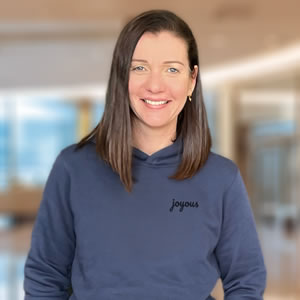Ruby Kolesky Podcast Transcript
Ruby Kolesky joins host Brian Thomas on The Digital Executive Podcast.
Brian Thomas: Welcome to Coruzant Technologies Home of The Digital Executive Podcast. Do you work in emerging tech, working on something innovative or an entrepreneur? Apply to be a guest at www.coruzant.com/brand.
Welcome to The Digital Executive. Today’s guest is Ruby Kolesky. Ruby Kolesky is the CEO of Joyous, a cloud-based AI platform that helps organizations get actionable feedback on specific operational topics through private one-on-one chats at scale, the platform then automatically delivers a detailed action plan for leaders to execute with no manual work required.
Ruby first set out to be a standup comedian, but when that didn’t work out, she became a software engineer instead. That mix of humor, curiosity, and a deep understanding of people combined with a strong technical skill, has shaped her approach to building human-centered technology. She’s known as a forward-thinking product and data science leader and a new kind of technology executive who blends strategy, empathy, and innovation to drive meaningful change.
Well, good afternoon, Ruby. Welcome to the show.
Ruby Kolesky: Hey, Brian. Great to be here.
Brian Thomas: Absolutely my friend. I appreciate it. This is really cool. I think you might be the first, maybe the second, it’s been a few years, but a guest being out of New Zealand, which is amazing!
Ruby Kolesky: Really?! Out of 1,100 shows. That’s wild.
Brian Thomas: Yes. If I look back I probably do have a guest from New Zealand, but it’s must have been at least two, three years ago.
Ruby, I’m in Kansas City. It’s an 18 hour difference. I really appreciate you doing this. And I’m gonna jump into your first question. You originally aspired to be a standup comedian before pivoting into software engineering and product leadership. How does that early interest in humor, performance, or reading, people inform how you think about human-centered design, conversational AI and building feedback systems?
Ruby Kolesky: Wow, that’s such a, that’s a great question to come out the jump with actually. Yeah. So I guess not many engineers and our tech CEOs have a comedic background, but I think it makes perfect sense. Like, to me, and there was really more melodramatic stage comedy, I did do some standup, but comedy isn’t just about making people laugh.
It’s a lot of, it’s about observing people. It’s about understanding patterns and behavior. You gotta really craft narratives that resonate. And if you’re standing on a stage, trust me, you have to be really hyper attuned to how people react. And you have to do that in real time. And so if your audience isn’t laughing at you or they’re tuning out, you have to instantly.
React. And I think that translates to human-centered design if you in quite, quite, quite beautifully. So now as engineering leader, AI leader in tech when we build these products, especially with things like conversational AI or feedback systems, which is what my company joyous does, I think about that, like the human on the other side of the interaction.
Honestly, pretty much the same way I would think about an audience on a show. Like are they following the flow? Like are they seeing me react to them in a way they’re enjoying? Am I meeting them where they are? Is the product meeting them where they are in comedy? The feedback is instant. It’s allow for, it’s a silence.
And in product we have to design systems now, I guess even more and more with AI coming along that listen and adapt justice responsible. Responsibly. Yeah.
Brian Thomas: That’s awesome. Thank you. And I like the analogy and it’s cool, your background in comedy there, and you’re right, it’s more about just than laughing, but understanding people’s behavior.
You can see that in their body language, obviously, are they engaged? And your transition to tech and ai. Same thing, right? In product. Are your customers engaged? What are they really feeling? Are you actually listening to their feedback? I think that’s awesome. So I appreciate that.
And Ruby, Joyous positions itself as a dynamic con conversational alternative to legacy tools like Qualtrics and static surveys. What are the biggest pitfalls of traditional feedback systems and how does Joyce chat base model overcome them? What trade-offs did you have to make along the way?
Ruby Kolesky: Well. I mean, I think it’s pretty common knowledge.
The biggest pitfall of traditional feedback systems and survey systems, whether you are using them in a huge organization, the way people use choice, or even if you’re just a more smaller individual trying to gather some feedback, right? It’s a onetime transaction instead of an ongoing.
Conversations. So to me, tools like Qualtrics, they produce data that’s much more quantitative. So numbers oriented, it’s static. It’s really decontextualized. You get, I mean, think about it, you get charts and you get millions of charts but you don’t get stories and you certainly don’t get enough information to act on.
So. I think what most people are used to in that kind of context and in that kind of older world is that you kind of, you’re sending off some sort of annual survey, let’s just pick engagement. But I mean, a lot of people do customer surveys as well, and it’s a once or twice a year kind of a thing. And it’s the same thing over and over again.
And that’s really important because businesses and industries and the people that are working there and the work that they’re doing. It’s changing and it’s changing fast, and it’s changing sort of dramatically. And so when you’re asking me how does joyous overcome that? Well, I mean, that’s what’s been.
Honestly just really interesting with Joy, as you see. We took like a fundamentally different approach from from the beginning. We wanted to make feedback conversational. We wanted to make it lightweight and focused on what’s like happening at that moment, not just for the business, but for the employee too.
So. I guess instead of like a 60 question survey, once or twice a year we really just ask one or two specific action focused questions and it’s like sending a text, so it’s very, very easy. Except then you’re talking to an AI that’s dynamically following your lead in the conversation, which is kind of great ’cause it won’t judge you.
It is not gonna penalize you like it would if it was a leader or maybe someone in the company or you would fear that maybe even if it wasn’t real and it will be far more unbiased at including your ideas. Into the results that the executives see. So I think, that shift takes feedback from a much more like re reporting board level mechanism to a, I guess like a meaningful operating system that drives both growth and innovation, but really at like a very human level.
It just makes people’s jobs easier to do. Yeah. And I mean, you, I think you asked about trade offs along the way. Well, I guess people are really conditioned to those surveys as much as there are flaws with them. So for us we had to really rethink well they’re used to seeing metrics and numbers and like that’s their, I guess KPI.
We had to rethink how to measure impact when the signals are way more qualitative. ’cause we are looking for the actionable thing to do. We are looking for the action plan. We are looking, on how that can impact a business. So the evidence for us is much more about how many actions are surfaced, how many people are contributing ideas, how many ideas are they contributing, and then what are the dollar impact of those ideas, and how long does it take to realize those?
And it’s interesting, right? ’cause people don’t think of that of this as a way to use feedback. They’ve been conditioned to use it. For measurement. So I think for us, it’s been a journey in opening up people’s minds to that possibility. And for me, like getting the technology to do what we wanted to do.
You’d think it’d be easy or it was a slam dunk. But the AI side of things has just been such a significant hill to climb, especially with us. We’re trying to do something consistently securely. Super high quality. We work with the world’s biggest organizations and have been for years and like no one else is doing what we can do today.
And that was extremely hard. Yeah, I would say it’s been, it’s been quite a ride. But I think it’s a lot better way better than surveys. For sure. I,
Brian Thomas: I absolutely agree on that. Working in this space for a long time, doing service desk surveys twice a year. I totally get it. But, and that is the traditional pitfall, as you mentioned in these systems.
It’s a one-time transaction. It’s decontextualized. There’s not enough information. And again, it’s the same thing over and over again. What I like about your platform though, you’re, it’s that action focused questions. It’s feedback real time. Using ai, obviously it’ll be a lot more unbiased as well, which I really appreciate.
So you’re doing a great job there. I appreciate that. And Ruby, the next question. Despite leading an AI company, you believe human contact will become premium as organizations over automate interactions. Could you elaborate on that tension where automation is smart and helpful versus when human touch must be preserved, especially in employee experience or frontline feedback.
Ruby Kolesky: Yeah, it’s like such a hot topic for me. Like it’s on my mind honestly just all the time. It’s a real personal bugbear of mine. I mean, if you go look at our website be joyous.ai right at the bottom on the footer we have there, that we use AI to help humans and not replace them. And I think that like it’s such a risky time for us in the world as I think.
You have all these, I think, a myriad of extremely high value, valid applications of ai particularly around automation of like the kind of mundane manual tasks that a human interaction isn’t really that important in. But what I do see. Is and you will have seen this too, and no doubt your audience, so many companies wholesale letting go of, for example, customer success teams or customer service teams and bringing in AI agents instead.
In fact, you mentioned Qualtrics before and I always joke to my team about them saying that they’re building AI agents to bring empathy at scale. And I would say that is a crock of. Because you can’t tell me. Let’s just say as a for instance, in a really important critical moment in your journey as a customer, let’s say you’re about to miss a flight or something really bad has happened and you’re very stressed about it, and you try to connect with an organization to get yourself through that really difficult moment, the last thing you wanna be do doing is talking to a bot.
Like, I can’t think of anything worse. And so, I just think there’s this huge risk that some people are gonna go too far and they’re gonna let go entire workforces. They’re gonna go really all in on AI in a way that replaces humans not supporting them. And I think that entire businesses are gonna fall and we’re gonna see a huge course correction.
And honestly, I believe humans are gonna become premium experiences, not ai. And I am, this is my prediction, I’m calling it. I think there’ll be lots of great applications. Obviously we’re an application of AI as well, that is. Quite deep in ai. I mean, we have 11 applications of AI chain together in a workflow. So I am saying this as a the CEO of an AI company, but it is a wholeheartedly what I believe.
Brian Thomas: That’s awesome. Thank you for sharing your insights there. And like you mentioned, this is a big topic to you and to me. I talk to CEOs all the time on this podcast that work in this space. And a trend that I’m seeing, you said you’re seeing is this, these customer service or success teams are starting to be replaced rapidly by bots.
And I agree that could backfire. Drastically to their business. But I believe in a hybrid approach. I believe in stepping into it slowly, but we’ll see what happens. But I would certainly agree with with you on that point. Absolutely. Ruby, the last question of the day, looking back on Joyce’s journey, what are some failures or blind spots you faced in product go to market adoption or scaling, and how did you course correct?
And looking forward, what is your vision for the next generation of feedback systems, AI and human systems, and what role will Joyous play
Ruby Kolesky: Blind Spots? There have been many failures as well. I don’t think anyone gets to the kind of point that we have with Joyous, which admittedly still has a long way to go, but you’ve gotta have made millions of mistakes to get to where we are.
And I think probably one of the early blind spots at Joyous was. Well, a little bit of, I think everyone does this, just the as assumption that if we put this thing out there which we did now more than five years ago that the product would speak for itself and that if we just delivered a better product, like adoption would just magically come along and follow us.
And it didn’t also. We did something pretty strange for a SaaS company or a tech company. We targeted the world’s largest organizations as the first thing we wanted to do. So we did not invest in product-led growth. We did not try to go to small to medium enterprise and then stretch up to enterprise.
We went straight to enterprise. One of our first clients is one of the largest organizations in the world. I’m not sure if that was necessarily the best way to go. I mean, we didn’t invest at all at product-led growth. I mean, I’m kind of really happy we followed that lead now and that’s caused us to arrive at this, honestly, insanely killer a product we have today. But in retrospect, probably making it more generally accessible, a lot sooner would’ve been possibly a way to go about this a bit faster. But that is what we’re doing now. I think the other, honestly, one-on-one mistake that we made is we didn’t wanna associate or compare ourselves to anything else but.
Even in the chat I’ve had with you, it’s much clear now that we are comparing ourselves to survey. And that was such a mistake ’cause people just couldn’t understand like, what are we, wait, what are we trying to replace with you? Oh, we’re like nothing else you’ve ever seen doing things we’ve no one’s done before.
And they’re like, well, well how do we budget for that? So listen learned, on that front. I think you asked what’s my vision? Is that right? For the next generation?
Brian Thomas: Yeah. Assistant feedback systems. Yeah.
Ruby Kolesky: Yeah, let me think about that. Well, I think that what excites me, and I think that that’s kind of closely aligned with the vision for joyous and certainly stuff I think about all the time is real impact at scale.
So seeing whole inter large enterprises adopt sort of conversational, actionable feedback, particularly from frontline staff, that leads to real improvements. Not just in efficiency and bottom line, but in morale and safety and not just about nice to have, I mean, like our goal and what we’re already doing is delivering tens or hundreds of millions of savings annually for some of our customers.
And kind of saying goodbye to that old school mindset around feedback and surveys. Like, forget measurement. It’s a waste of time, measuring scores. And I guess kind of really rolled into that for me in terms of like the future of feedback is democratization of voice. Like technology can now give voice to people who just historically haven’t had it.
And I mean, like, we are really, really passionate, joyous is built for field workers, for people out in the fields doing the hard work every day. Like I’m talking about the people out in the trucks. Doing work in people’s houses, doing workout and infrastructure. I’m talking about, the doctors and the nurses and the other people really, really out in the front lines.
It’s the people, in my opinion and in the opinion of everyone at Joyce and all of our great customers, that it’s the people out in the front who do the work every single day, who know what it will take. And they have that information right in front of them on how to make this business succeed. And I’m just really excited about our advances with ai.
Making not only their voice get raised up, but that information accessible to the leaders whose intimidating job it is to make that decision. Now having like all of this data behind them to ensure that they can leverage these real time feedback loops to just really give themselves a huge advantage.
And. When you think about it in the context of things, for example, healthcare or airlines or whatever industry where you typically have huge workforces, they can actually more successfully deliver those services, which can, we are talking saving lives here, kind of impact, which is incredible.
Yeah, and I mean, I think it is kind of happening, I’m like certainly like things have shifted for us significantly, particularly I’d say in the last 12 months. I think people have been attuned to like this sort of shift is a real thing and it’s not hype. And then feedback is actually a really great, great application of AI to ensure more momentum in an industry and give these people a voice.
So I see it in the investment. I see it in the adoption of our product. I see like so many people tossing out those more legacy systems for ours, almost like with urgency. So I’m not sure how far away the this feature is, and I think it’s great.
Brian Thomas: That’s awesome. I really appreciate that. And just highlight a few things. You talked about some of the mistakes you learned, you obviously talked about that. But looking ahead, the real impact at scale, and again, I’m just paraphrasing, but the actionable insights on the front line, millions of savings across enterprises. And of course the thing that I really highlighted and took away is that importance with democratization of voice.
People being able to be heard, to make those improvements across the customer spectrum, I think was probably the most important takeaway that I took there. And I really appreciate that. Ruby, it was such a pleasure having you on today, and I look forward to speaking with you real soon.
Ruby Kolesky: I really enjoyed the conversation.
Those were very good questions and I have loved meeting you. So thank you so much, and goodbye from the future.
Brian Thomas: Absolutely. Bye for now.
Ruby Kolesky Podcast Transcript. Listen to the audio on the guest’s Podcast Page or read the guest’s feature article.











